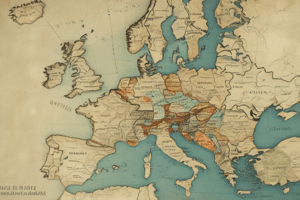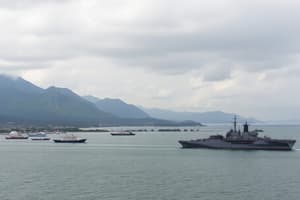Podcast
Questions and Answers
What were some of the political, economic, and social changes in Egypt during different dynasties?
What were some of the political, economic, and social changes in Egypt during different dynasties?
- Shifts in power, agricultural developments, and changes in social hierarchies (correct)
- Introduction of a new currency system and establishment of a parliamentary democracy
- Adoption of a presidential system and complete overhaul of the legal framework
- Formation of a federal government and implementation of universal suffrage
What was one of the effects of encounters with 'others' on societies and environments?
What was one of the effects of encounters with 'others' on societies and environments?
- Isolationist policies and reduced agricultural productivity
- Erosion of cultural identity and depletion of natural resources (correct)
- Decline in technological advancements and disruption of societal norms
- Enrichment of cultural diversity and preservation of ecological balance
What were some achievements of the Byzantine Empire?
What were some achievements of the Byzantine Empire?
- Expansion of military capabilities and implementation of socialist economic policies
- Development of a comprehensive welfare system and promotion of democratic ideals
- Advancements in science, preservation of Roman law, and construction of architectural marvels (correct)
- Establishment of a constitutional monarchy and advocacy for gender equality
What was a significant aspect of the decline of the Roman, Chinese, and Indian civilizations?
What was a significant aspect of the decline of the Roman, Chinese, and Indian civilizations?
What was one of the consequences of the Feudal system?
What was one of the consequences of the Feudal system?
What was a significant impact of the Crusades on trade routes?
What was a significant impact of the Crusades on trade routes?
What was a common characteristic of the Fatimid and Mamluk dynasties in Egypt?
What was a common characteristic of the Fatimid and Mamluk dynasties in Egypt?
What was one of the effects of the Black Death in Cairo?
What was one of the effects of the Black Death in Cairo?
How did encounters with 'others' impact societies and environments?
How did encounters with 'others' impact societies and environments?
What was a noteworthy characteristic of the Abbasids Caliphate's economy?
What was a noteworthy characteristic of the Abbasids Caliphate's economy?
What was a significant influence of perceptions of 'others' on expansion?
What was a significant influence of perceptions of 'others' on expansion?
What was a notable characteristic of the decline of the Roman, Chinese, and Indian civilizations?
What was a notable characteristic of the decline of the Roman, Chinese, and Indian civilizations?
What was one of the causes of decline for the Fatimids and Mamluks in Egypt?
What was one of the causes of decline for the Fatimids and Mamluks in Egypt?
What was one of the effects of the Black Death in Cairo?
What was one of the effects of the Black Death in Cairo?
Flashcards
Dynastic Shifts in Egypt
Dynastic Shifts in Egypt
Each dynasty experienced changes in political structure, economic activities, and social hierarchies.
Effects of Cultural Exchanges
Effects of Cultural Exchanges
Interactions led to technological advancements, spread of ideas and goods, as well as diseases, reshaping demographics and economies.
Achievements of Byzantine Empire
Achievements of Byzantine Empire
Preserved Roman law and culture through the Justinian Code, architectural innovations like the Hagia Sophia, and expanded diplomacy and trade.
Decline of Civilizations
Decline of Civilizations
Signup and view all the flashcards
Consequences of Feudal System
Consequences of Feudal System
Signup and view all the flashcards
Impact of the Crusades
Impact of the Crusades
Signup and view all the flashcards
Fatimid & Mamluk Characteristics
Fatimid & Mamluk Characteristics
Signup and view all the flashcards
Black Death in Cairo
Black Death in Cairo
Signup and view all the flashcards
Abbasid Caliphate Economy
Abbasid Caliphate Economy
Signup and view all the flashcards
Perceptions of 'Others'
Perceptions of 'Others'
Signup and view all the flashcards
Decline of Fatimids/Mamluks
Decline of Fatimids/Mamluks
Signup and view all the flashcards
Effects of Black Death
Effects of Black Death
Signup and view all the flashcards
Study Notes
Political, Economic, and Social Changes in Egypt
- Each dynasty in Egypt, such as the Old, Middle, and New Kingdoms, saw shifts in political structure, such as centralization of power or regional autonomy.
- Economic activities evolved with advancements in trade, agriculture, and resource management, influencing social hierarchies.
- Social changes included shifts in class structures, increased urbanization, and changes in religious practices that affected daily life.
Effects of Encounters with 'Others'
- Cultural exchanges led to technological advancements, such as agricultural methods, influencing both societies and environments.
- Interactions with neighboring civilizations resulted in the spread of ideas, goods, and diseases, reshaping demographics and economies.
Achievements of the Byzantine Empire
- Known for the preservation of Roman law and culture through the Justinian Code.
- Significant architectural innovations, exemplified by the Hagia Sophia, showcasing advanced engineering and aesthetic beauty.
- Diplomacy and trade networks expanded, solidifying its role as a bridge between East and West.
Decline of Civilizations
- The decline of the Roman, Chinese, and Indian civilizations often involved internal strife, economic instability, and external invasions.
- A decline in agricultural production and increased taxation strained resources, contributing to societal collapse.
Consequences of the Feudal System
- Established a hierarchical structure, where land ownership was tied to loyalty and military service, influencing societal roles and relationships.
- Created economic disparities and limited social mobility, as serfs were bound to the land and owed labor to lords.
Impact of the Crusades on Trade Routes
- Increased interaction between Europe and the East, revitalizing trade routes and introducing new goods and ideas.
- Shifted focus to Mediterranean trade, influencing the economy and leading to the rise of merchant classes.
Characteristics of Fatimid and Mamluk Dynasties
- Both dynasties exhibited strong military organization and governance, fostering relative stability in Egypt.
- Cultural and intellectual advancements flourished, with emphasis on scholarship and the arts.
Effects of the Black Death in Cairo
- Significant population decline led to labor shortages, causing social and economic upheaval.
- Shifts in societal attitudes toward religion and authority emerged as people sought meaning in the face of widespread mortality.
Economic Characteristics of the Abbasid Caliphate
- The Abbasid economy thrived on trade and agriculture, supported by a sophisticated network of markets and infrastructure.
- Innovation in financial instruments and methods, such as checks and banking systems, facilitated commerce.
Influence of Perceptions of 'Others' on Expansion
- Negative perceptions often justified conquests and colonization, spurring territorial expansion driven by a desire for resources and security.
- Encounters often resulted in the blending of cultures, while simultaneously reinforcing stereotypes and biases.
Causes of Decline for Fatimids and Mamluks
- Internal conflicts and power struggles weakened central authority, leading to fragmentation and vulnerability to external threats.
- Economic pressures and changing trade routes diminished their former economic power.
Notable Effects of the Black Death in Cairo
- Transformation of labor dynamics, leading to increased wages for workers as demand exceeded supply.
- Alterations in social structures, with some previously rigid class divisions becoming more permeable due to shifts in wealth and power dynamics.
Studying That Suits You
Use AI to generate personalized quizzes and flashcards to suit your learning preferences.




